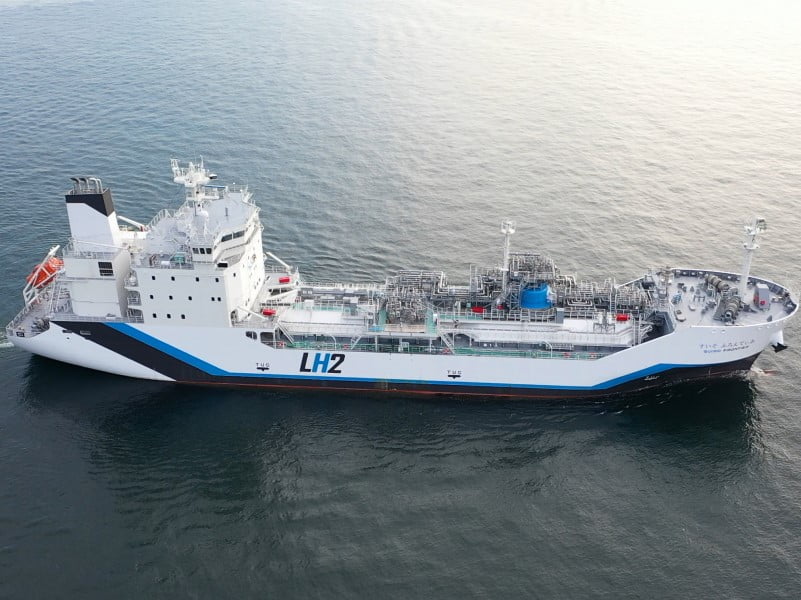A Gippsland-based initiative to make clean hydrogen from coal using carbon capture, utilisation, and storage technologies will be commercialised following a $2.35 billion commitment from the Japanese government.
The funding will support the Hydrogen Energy Supply Chain project. This involves a joint venture between Japanese companies J-Power and Sumitomo Corporation to initially produce 30,000 tonnes of blue hydrogen annually, while Japan Suiso Energy (JSE) will liquify the hydrogen and export the hydrogen to Japan.
It comes after the Hydrogen Energy Supply Chain (HESC) project delivered the world’s first shipment of liquid hydrogen in February 2022, although this was for brown hydrogen – produced from coal gasification without the use of carbon capture technology.
HESC is a consortium of several industry partners, mostly based in Japan, that also includes AGL Energy and Royal Dutch Shell.

Funding for the project comes from Japanese government’s 10-year ¥2 trillion (AUD$22 billion) Green Innovation Fund Project. The Japanese government wants the country to consume 3 million tonnes of hydrogen per annum by 2030.
The project aims to use carbon, capture, storage, and utilisation technology alongside the high carbon dioxide emitting coal and biomass gasification process to produce blue hydrogen.
Two Gippsland carbon storage options are under consideration, CarbonNet, which is targeting being operational by 2027, and Exxon Mobil’s Gippsland Basin Joint Venture South East Australian Carbon Capture Storage Hub which could be operational by 2025.
Hydrogen produced from by the joint venture is expected to comply with the Australian government’s definition of clean hydrogen under the Guarantee of Origin Scheme, currently under development.
Earlier this year, Climate Change and Energy minister Chris Bowen told reporters in Germany that the federal government is “dedicated to green hydrogen” but acknowledged that there are projects in the pipeline for blue hydrogen.
Green hydrogen is produced from the electrolysis of water, powered by renewable energy.
J-Power Latrobe Valley non-executive director Jeremy Stone said the company is excited to “make commercial scale hydrogen production in Victoria a reality”.
“This is a major milestone and a recognition of Gippsland’s unique ability to help reduce global CO2 emissions through the reliable production of large quantities of cost competitive and clean hydrogen,” he said.
“Bringing commercial scale hydrogen production to the Latrobe Valley will act as a catalyst for growth in the broader Gippsland region, as complementary industries such as Ammonia, Fertiliser and Methanol are attracted to the opportunities it presents.”
Subject to commercial agreements and environmental approval, the project is expected to commence hydrogen production by the late 2020s, according to Mr Stone.
JSE chief executive Dr Eiichi Harada said the grant commitment is a “watershed moment” after a decade of work with the Japanese, Australian, and Victorian governments.
Australian Hydrogen Council chief executive Fiona Simon said the announcement is a “vote of confidence in Australia’s ability to export hydrogen at commercial scale”.
“We congratulate the Australian and Japanese industry partners on reaching this important milestone, which is a great example of two nations combining skills, technology and investment to progress the global hydrogen economy,” Dr Simon said.
“This is a positive step forward in reaching Australia’s ambitious hydrogen export goals and we look forward to seeing this project progress to the commercial demonstration phase.”
HESC claims its hydrogen production facility, when scaled to an annual output of 225,000 tonnes per annum, would reduce carbon emissions by 1.8 million tonnes, the equivalent of removing 350,000 petrol cars.
Last year, the Australia Institute expressed concerns that the HESC project is relying on CCS developments external to its project. It highlighted that if no CCS is attached to the fully scaled Gippsland plant, it would increase carbon emissions by up to 3.8 million tonnes, equivalent to 735,000 petrol cars.
The effectiveness of carbon capture and storage technology has also been questioned, with former Prime Minister Malcolm Turnbull previously labelling it a “scam and a con”.
“CCS is a proven failure. There was a time when I was John Howard’s environment minister when we thought CCS would work,” Mr Turnbull said.
Australia’s only commercial-scale CCS project is operated by Chevron at its Gorgon liquefied natural gas plant in Western Australia, which stores just over 2 million tonnes of carbon dioxide per annum – about half of the 4 million tonnes it is supposed to target.
In a speech to the Australia and Southeast Asia Global CCS Institute Forum last month, Resources minister Madeleine King said the Gorgon CCS project has failed to meet expectations, but sought to “acknowledge their efforts and investment in progressing practical CCUS”.
Ms King also told the conference that “Australia has the ability to become a world leader in the emerging carbon capture industry, with large, stable geological formations for greenhouse gas storage”.
Do you know more? Contact James Riley via Email.

